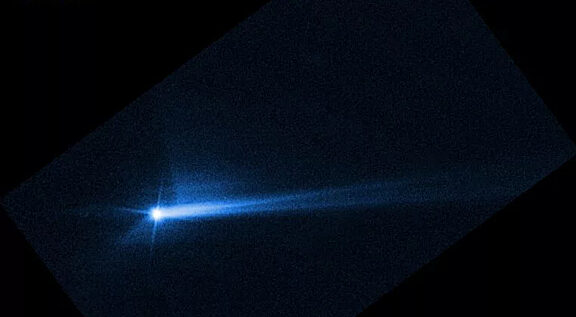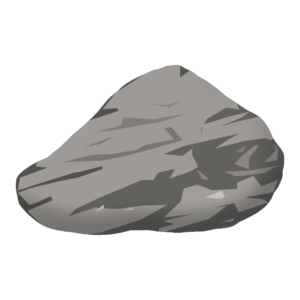The Downlink • Oct 14, 2022
Good omens
Space Snapshot

Throughout human history, comets have been seen as omens of doom and disaster. Although this may look like a comet, with its long tail trailing behind it, what you see here is actually an asteroid — and a much more positive portent. This image taken by the Hubble Space Telescope shows asteroid Dimorphos and its tail of debris 285 hours after it was impacted by NASA’s DART (Double Asteroid Redirection Test) spacecraft. Today, we know for certain that this first-ever attempt to alter the trajectory of an asteroid was successful. This is a very good omen for the future of our planet, as we continue to learn how to defend it from impacts. Image credit: NASA/ESA/STScI/Hubble.
You love space, now take action
This weekly newsletter is your toolkit to learn more about space, share information with your friends and family, and take direct action to support exploration. Anyone can subscribe at planetary.org/connect to receive it as a weekly email.
Mission Briefings


DART was officially a huge success. NASA Administrator Bill Nelson confirmed that DART successfully altered Dimorphos’ trajectory, bringing it closer to its parent asteroid Didymos and decreasing the time it takes to orbit Didymos by 32 minutes. NASA had defined a minimum successful orbit period change of Dimorphos as a change of 73 seconds or more, meaning DART surpassed its minimum success requirements by more than 25 times. Pictured: The Italian Space Agency's LICIACube spacecraft captured this image of plumes of ejecta coming from Dimorphos. Each rectangle shows a different level of contrast to better see fine structure in the plumes. Image credit: ASI/NASA/APL.

Asteroid impacts throughout Earth’s history are mirrored on the Moon. New research using lunar samples collected by the Chinese National Space Agency’s Chang’e-5 mission suggests that major impact events on the Earth coincided with impacts on the Moon. This research, which involved collaborators from universities in Australia, China, the US, the UK, and Sweden, offers insights into the conditions of the early Solar System when asteroid impacts were more common.

JWST has imaged a planetary system in the making. Mark McCaughrean, senior advisor for science & exploration at the European Space Agency, tweeted a new image from the space telescope showing the silhouette of a young star surrounded by a dense disk of gas and dust from which planets may be being built.
From The Planetary Society


Would a signal from an alien civilization be seen as a good omen? Many theorists and writers have considered how humanity would react to a signal from an extraterrestrial intelligence. Professor Jason Wright, director of the Penn State Extraterrestrial Intelligence Center, joins Planetary Radio: Space Policy Edition to discuss a particular angle on this question: how the world’s governments might respond to finding ET. Pictured: An illustrated view of the National Radio Astronomy Observatory's Very Large Array in New Mexico. Image credit: NRAO.

NASA’s Innovative Advanced Concepts symposium is where sci-fi becomes reality. The NIAC grant program allows researchers, engineers, and entrepreneurs to develop visionary ideas that could transform space science and exploration. This week’s Planetary Radio features interviews with presenters at NIAC’s annual conference, showcasing projects that push the boundaries of what might be considered possible.

Zed Factor Fellowship applications are now open for the class of 2023. This program empowers aspiring aerospace professionals from historically-excluded backgrounds through practical hands-on experience, leadership training, and community. The Planetary Society has worked with two Zed Factor Fellows in paid summer internships, which are just one facet of the valuable experience that Fellows receive through this program. Applications are due Jan. 2nd, 2023.

JWST has the potential to illuminate the outer Solar System. As the space telescope continues its mission of exploring the Universe with greater depth and sensitivity than any telescope, it will be able to see Kuiper belt objects — those beyond the orbit of Neptune — in an entirely new light. Learn more about the mysteries this powerful new tool may be able to solve.
What's Up

The evening sky is great for planet viewing, with bright Jupiter rising in the east at sundown and crossing the sky all night. Yellowish Saturn shines a bit higher in the sky. A couple of hours later, Mars rises in the east, and on Oct. 14 it will shine alongside the Moon. The Orionids meteor shower peaks over the night of October 20-21. Check out our guide to the rest of this month’s night skies.
Wow of the Week

The NASA Innovative Advanced Concepts program includes a few unique ideas about what to do with asteroids. This artist’s impression depicts “Project RAMA” (Reconstituting Asteroids into Mechanical Automata), led by 2016 NIAC Fellow Jason Dunn. The idea behind this project was to convert entire asteroids into enormous autonomous mechanical spacecraft. This is just one of the many fascinating concepts explored through NIAC grants. Image credit: NASA.
Send us your artwork!
We love to feature space artwork in the Downlink. If you create any kind of space-related art, we invite you to send it to us by replying to any Downlink email or writing to [email protected]. Please let us know in your email if you’re a Planetary Society member!


 Explore Worlds
Explore Worlds Find Life
Find Life Defend Earth
Defend Earth


